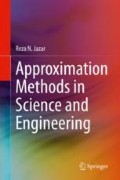Abstract
In this chapter we review the method of continued fractions to show its advantage and application. Convergence and its usefulness in working with irrational numbers, as well as converting a numerical series to continued fraction back and forth are the topics of this chapter. This review makes the reader ready to derive and work with solution of differential equations in continued fractions.
We will show that all real numbers may be divided into rational and irrational. They also may be divided into algebraic and transcendental. A rational number can be expressed by a fraction of the form p/q where p and q are integers. Numbers are also either algebraic or transcendental. The method expressing rational and irrational numbers by continued fractions will be covered in this chapter to make the reader ready to solve differential equations in continued fractions.
Access this chapter
Tax calculation will be finalised at checkout
Purchases are for personal use only
References
Aydin, N., & Hammoudi, L. (2019). Al-Kāshı̄’ās Miftā h. al-Hisab, Volume I: Arithmetic. Birkhäuser, Cham: Springer Nature.
Bailey, D. H., & Borwein, J. M. (2016). Pi: The next generation: A sourcebook on the recent history of Pi and its computation. Cham: Springer.
Battin, R. H. (1999). An introduction to the mathematics and methods of astrodynamics. Reston, VA: American Institute of Aeronautics and Astronautics.
Beckmann, P. (1971). A history ofπ(PI). New York: St. Martin’s Press.
Ben-Dov, J., Horowitz, W., & Steele, J. M. (2012). Living the lunar calendar. Oxford, UK: Oxbow Books.
Borwein, J. M., & Bailey, D. (2008). Mathematics by experiment, plausible reasoning in the 21st century. New York: CRC Press.
Borwein, J. M., & Borwein, P. B. (1987). Pi and the AGM. New York: Wiley.
Clawson, C. C. (1996). Mathematieal mysterles: The beauty and magie of numbers. New York: Springer.
Dershowitz, N., & Reingold, E. M. (2008). Calendrical calculations (3rd ed.). New York, USA: Cambridge University Press.
Euler, L. (1988). Introduction to analysis of the infinite. New York: Springer. Euler’s work to 1800, Book I, Translated by J. D. Blanton.
Feeney, D. (2007). Caesar’s calendar: Ancient time and the beginnings of history. Los Angeles, CA: University of California Press.
Gray, L. H. (1907). On certain Persian and Armenian month-names as influenced by the Avesta calendar. Journal of the American Oriental Society, 28, 331–344.
Hannah, R. (2005). Greek and Roman calendars, constructions of time in the classical world. London, UK: Gerald Duckworth & Co. Ltd.
Hardy, G. H., & Wright, E. M. (2008). An introduction to the theory of numbers (6th ed.). London, UK: Oxford University Press.
Herz-Fischler, R. (1987). A mathematical history of the golden number. Mineola, NY: Dover.
Idem. (1965). The Iranian calendar, in Zoroastrian studies (2nd ed., pp. 124–131). New York: AMS Press.
Jonathan, M. B., & Chapman, S. T. (2015). I prefer Pi: A brief history and anthology of articles in the American mathematical monthly. The American Mathematical Monthly, 122(3), 195–216.
Khinchin, A. Y. (1997). Continued fractions. New York: Dover.
Khrushchev, S. (2008). Orthogonal polynomials and continued fractions. Cambridge, UK: Cambridge University Press.
Kline, M. (1972). Mathematical thought from ancient to modern times (Vol. 1). New York: Oxford University Press.
Lorentzen, L., & Waadeland, H. (2008). Numerical computation of continued fractions. In Continued fractions. Atlantis studies in mathematics for engineering and science (Vol. 1). Atlantis Press.
Lyusternik, L. A., & Yanupolskii, A. R. (1965). Mathematical analysis, functions, series, and continued functions. London, UK: Pergamon Press. Translated by D. E. Brwn.
Merzbach, U. C., & Boyer, C. B. (2011). A history of mathematics (3rd ed.). Hoboken, NJ: Wiley.
Morony, M. (2012). ARAB II. Arab conquest of Iran. In Encyclopaedia Iranica (Vol. II, pp. 203–210).
Müller, J. H. (1920). On the application of continued fractions to the evaluation of certain integrals, with special reference to the incomplete Beta function. Biometrika, 22, 284–297.
Olds, C. D. (1963). Continued fractions. New York: Random House.
Pacioli, L. (1509). De divina proportione (On the Divine Proportion), Venice: Alessandro and Paganino de’ Paganini, Republic of Venice.
Panaino, A., Abdollahy, R., & Balland, D. (1990). Calendars. Encyclopaedia Iranica (Vol. IV, pp. 658–677), Fasc. 6–7.
Philip, A. (1921). The calendar, its history, structure and improvement. Cambridge: Cambridge University Press.
Pringsheim, A. I. (1898). Ueber die ersten Beweise der Irrationalität von e und π. Sitzungsberichte der Bayerischen Akademie der Wissenschaften Mathematisch-Physikalische Klasse, 28, 325–337.
Rogers, L. J. (1893). On the expansion of some infinite products. Proceedings of the London Mathematical Society, 24, 337–352.
Saha, M. N., & Lahiri, N. C. (1955). History of the calendar in different countries through the ages. New Delhi: Council of Scientific & Industrial Research.
Shidlovskii, A. B. (1989). Transcendental numbers. New York: Walter de Gruyter.
Silverman, J. H. (2011). A friendly introduction to number theory (4th ed.). London, UK: Pearson Education.
Stolz, O. (1885). Vorlesungen über allgemeine Arithmetik: nach den Neueren Ansichten (pp. 173–175). Leipzig: Teubners.
Tabak, J. (2004). Numbers: Computers, philosophers, and the search for meaning. New York: Facts On File.
Yanpolskii, L. A., & Lyusternik, A. R. (1965). Mathematical analysis. New York: Pergamon Press.
Author information
Authors and Affiliations
Rights and permissions
Copyright information
© 2020 Springer Science+Business Media, LLC, part of Springer Nature
About this chapter
Cite this chapter
N. Jazar, R. (2020). Numerical Continued Fractions. In: Approximation Methods in Science and Engineering. Springer, New York, NY. https://doi.org/10.1007/978-1-0716-0480-9_3
Download citation
DOI: https://doi.org/10.1007/978-1-0716-0480-9_3
Published:
Publisher Name: Springer, New York, NY
Print ISBN: 978-1-0716-0478-6
Online ISBN: 978-1-0716-0480-9
eBook Packages: Intelligent Technologies and RoboticsIntelligent Technologies and Robotics (R0)

